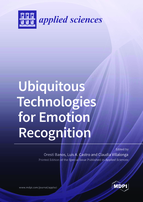Ubiquitous Technologies for Emotion Recognition
A special issue of Applied Sciences (ISSN 2076-3417). This special issue belongs to the section "Computing and Artificial Intelligence".
Deadline for manuscript submissions: closed (15 July 2020) | Viewed by 52409
Special Issue Editors
Interests: wearable, ubiquitous, and mobile computing; artificial intelligence; data mining; digital health
Special Issues, Collections and Topics in MDPI journals
Interests: human–computer interaction; ubiquitous and mobile computing; mobile sensing; context awareness; behaviour and context sensing
Special Issues, Collections and Topics in MDPI journals
Special Issue Information
Dear Colleagues,
Emotions play a very important role in how we think and behave. As such, the emotions we feel every day can compel us to act and influence the decisions and plans we make about our lives. Being able to measure, analyze, and better comprehend how or why our emotions may change is thus of much relevance to understand human behavior and its consequences. Despite the great efforts made in the past in the study of human emotions, it is only now with the advent of wearable, mobile, and ubiquitous technologies that we can aim at sensing and recognizing emotions, continuously and in the wild. This Special Issue aims at bringing together the latest experiences, findings, and developments regarding ubiquitous sensing, modelling, and recognition of human emotions.
Original, high-quality contributions from both academia and industry are sought. Manuscripts submitted for review should not have been published elsewhere or be under review by other journals or peer-reviewed conferences.
Topics of interest include, but are not limited to:
- Wearable, mobile, and ubiquitous emotion recognition systems
- Algorithms and features for the recognition of emotional states from face, speech, body gestures, and physiological measures
- Methods for multi-modal recognition of individual and group emotion
- Benchmarking, datasets, and simulation tools that have been applied to study and/or support emotion recognition
- Applications of emotion recognition including education, health care, entertainment, vehicle operation, social agents, and ambient intelligence
Prof. Dr. Oresti Banos
Prof. Dr. Luis A. Castro
Prof. Dr. Claudia Villalonga
Guest Editors
Manuscript Submission Information
Manuscripts should be submitted online at www.mdpi.com by registering and logging in to this website. Once you are registered, click here to go to the submission form. Manuscripts can be submitted until the deadline. All submissions that pass pre-check are peer-reviewed. Accepted papers will be published continuously in the journal (as soon as accepted) and will be listed together on the special issue website. Research articles, review articles as well as short communications are invited. For planned papers, a title and short abstract (about 100 words) can be sent to the Editorial Office for announcement on this website.
Submitted manuscripts should not have been published previously, nor be under consideration for publication elsewhere (except conference proceedings papers). All manuscripts are thoroughly refereed through a single-blind peer-review process. A guide for authors and other relevant information for submission of manuscripts is available on the Instructions for Authors page. Applied Sciences is an international peer-reviewed open access semimonthly journal published by MDPI.
Please visit the Instructions for Authors page before submitting a manuscript. The Article Processing Charge (APC) for publication in this open access journal is 2400 CHF (Swiss Francs). Submitted papers should be well formatted and use good English. Authors may use MDPI's English editing service prior to publication or during author revisions.
Keywords
- emotion recognition
- multi-modal sensing
- wearable, mobile and ubiquitous computing
- affective computing








